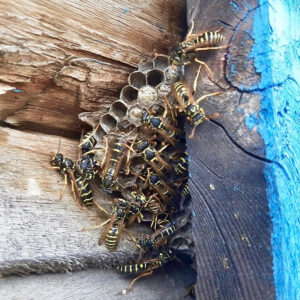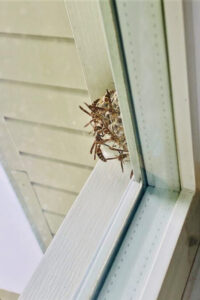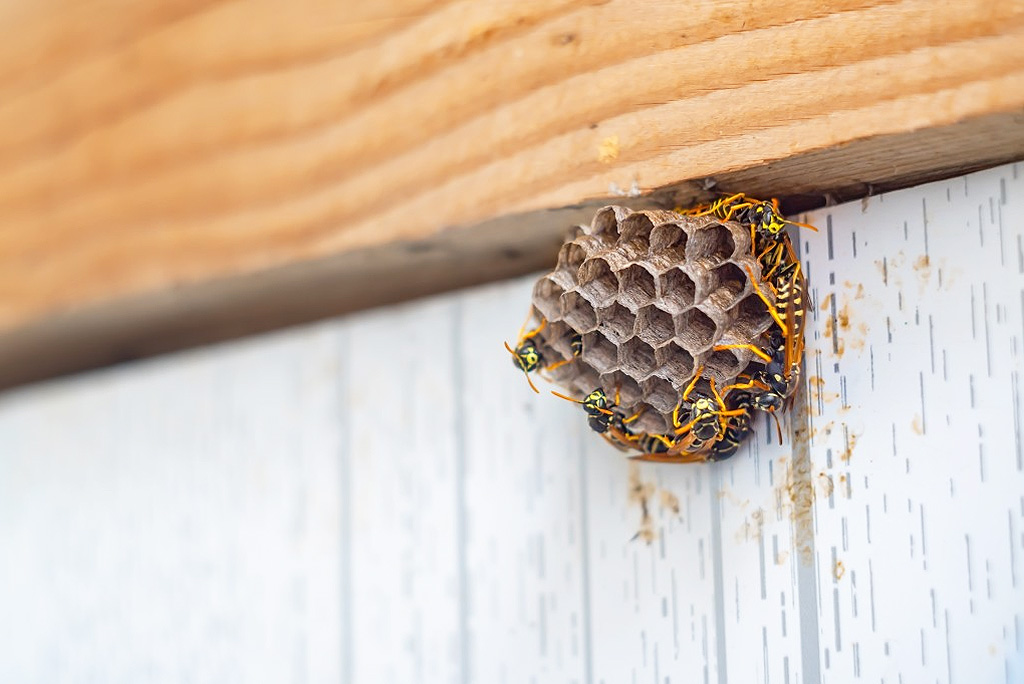In spring, wasps start searching for locations where they can build their nests and stay safe, away from the elements and predators. They are most active in the early summer, with fully populated colonies, and therefore are most noticeable flying outside the nest and often ending up in your house.
Keep reading to learn more about why wasps seem to be attracted to your house and their nesting habits.
Why Do Wasps Come Into The House?
One of the reasons wasps come into the house can be their attachment to the area where you live. Even though they don’t return to the exact same site for nesting, they will build a new nest in the same vicinity, and it could happen to be your house again.
However, in most cases, wasps will be attracted to your home and might come indoors as they are looking for a suitable nesting site, new sources of food for themselves and the nest members, a sheltered place to hibernate in winter, and also by accident.
Wasps usually come into the house whenever their nest is constructed inside or near openings leading into the home, such as near a window or an entry door that is left open.
You might often see these insects going in and out of a void or attic space, which makes you seal up their entry and exit points before all of the wasps in that nest die. As a result, the whole nest of wasps gets trapped inside the house and cannot get outside anymore. The pests become confused and furious, and start chewing through the wall or ceiling.
Wasps might seek protected, undisturbed indoor spaces where they can hibernate. The wasp colony needs to survive the winter, so its queen chooses a site such as a siding, attic, or another sheltered site inside the home to stay very cozy. If they sense heat coming out from your house, the wasps will be drawn to burrow their way in through any holes and crevices.
Once the queen is settled, the wasps usually don’t fly around the home during the winter. But when the queen wakes up from hibernation and wants to get outdoors again in the spring and start building a new nest to lay eggs, this is when the insects can get bothersome and disturbing.

Wasps might enter by accident through an open window or door, or be unintentionally brought inside if they happen to “hitch a ride” on you or anything you bring inside your home without noticing the wasp. As the insects are constantly on the lookout for new food sources, it’s no wonder that they would want to explore the inside of your house if they can get inside with ease.
They also need a fair amount of water. So, for example, if you have open cans of soda or juice, ripe fruits, and other sweet food sources, they will attract wasps. Make sure to cover any drinks and open food containers, and keep a lid on the trash can. Light sources in your house at night can also attract any flying insects, including wasps, into your home. Leaving dead wasps lying around on the surfaces can attract other wasps inside. Wasps are naturally attracted to bright, floral decor items, so make sure to put these away from the windows and doors.

Where Are Wasps Coming From?
Wasps will nest anywhere, be it in hollow trees, rock crevices, underground, or in man-made structures. In general, they can access your home through any pre-existing gaps and openings that lead inside.
There are many different entry points for wasps, and they are able not only to fly in, but can also crawl into your house. The tiny holes and cracks in your home’s exterior like on the walls, window sills, or door frames, are enough for them to crawl inside.
If the wasp nest is in a wall cavity, the insects usually come in through holes in the floor, gaps where pipes pass through floors and walls, gaps around boxed-in pipework, and also through gaps around frames and bath panels.
In addition, they can cleverly enter the house through the vent in areas such as the bathroom, kitchen, basement, or chimney.
What To Do If There Are Wasps In Your House?
The bad news is that a wasp is able to live a long time if trapped indoors, even up to four days. What’s worse, if it can find a continuous source of food and water, it can survive as long as three months. Therefore, you should let it out as soon as possible.
If you happen to see a wasp or wasps in your room, quickly close the door to that room while opening the windows so that it can fly out. Eventually, it will leave and join the rest of its colony.
Wasp nests can be dangerous because of where they are located, such as on the exterior of your house or even indoors. If the nest is built inside, you would deal with an infestation that may cause sting episodes. Especially if you or any household member is allergic to wasps, leaving the nest alone could pose a serious health issue. Wasps that nest inside might also damage your drywall or ceiling. Therefore, you should consider removing and destroying the nest as your top priority.
It’s essential to remove the nest entirely in order to treat a wasp infestation. Handling a wasp nest is a dangerous task as there is a high risk of getting stung. If you have a wasp nest in your home, do not attempt to get rid of it yourself as it will most likely end up being a very painful experience for you.
Instead, contact a professional pest control exterminator who will safely and efficiently do the job for you. If you are currently dealing with a wasp infestation problem, and you live in our service area in Atlanta, call Peachtree Pest Control for help!
